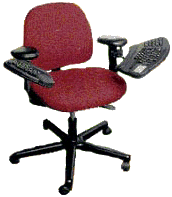Our own devices
 Edward Tenner, author of Why Things Bite Back: Technology and the Revenge of Unintended Consequences, has a new book called Our Own Devices: The Past and Future of Body Technology. Meticulously researched chapters trace the historical development of footgear, chairs, keyboards, and eyeglasses. The unifying theme is the coevolution of technology and technique: how we both change and are changed by these "body technologies" as we use them.
Edward Tenner, author of Why Things Bite Back: Technology and the Revenge of Unintended Consequences, has a new book called Our Own Devices: The Past and Future of Body Technology. Meticulously researched chapters trace the historical development of footgear, chairs, keyboards, and eyeglasses. The unifying theme is the coevolution of technology and technique: how we both change and are changed by these "body technologies" as we use them.
 Feet in barefoot or sandal-wearing cultures, for example, differ from feet in shod cultures, and so do styles of locomotion. I can walk all day in Birkenstocks at a brisk pace, but I can't sprint for a bus. It's a tradeoff I made years ago in response to a foot injury.
Feet in barefoot or sandal-wearing cultures, for example, differ from feet in shod cultures, and so do styles of locomotion. I can walk all day in Birkenstocks at a brisk pace, but I can't sprint for a bus. It's a tradeoff I made years ago in response to a foot injury.
 A different kind of injury -- repetitive strain -- landed me in what my friends call my "Captain Kirk keyboard chair" (aka Floating Arms). It has its own tradeoffs: I gain a radical redistribution of the load on my arms and shoulders while typing, complete realignment of my posture, and infinite adustability, but give up floor space and convenient access.
A different kind of injury -- repetitive strain -- landed me in what my friends call my "Captain Kirk keyboard chair" (aka Floating Arms). It has its own tradeoffs: I gain a radical redistribution of the load on my arms and shoulders while typing, complete realignment of my posture, and infinite adustability, but give up floor space and convenient access.
Meanwhile WiFi has ushered in a new technology/technique dynamic. The untethered TiBook is seductive, as are the many postures that can accommodate its use. Of course its keyboard would be useless to me were it not for a software modification that -- albeit imperfectly -- relocates the CONTROL key, all-important to the emacs user, to a less crippling location.
Tenner concludes with an essay on the newest form of mobile data entry, thumb-driven text messaging:
The major laboratories did not predestine the thumb as the successor to the index finger, though they did help make the thumb's usefulness possible. The full capacities of the digit were discovered through the joint experimentation of users, designers, and manufacturers.
And here is the lesson he draws from this example:
One challenge of advanced industrial societies is a degree of standardization that threatens to choke off both new technologies and new techniques. The remedy is a return to the collaboration between user and maker that marked so many of the great innovations, whether the shaping of the classic American fire helmet or the development of the touch method by expert typists.
It's a great point. I particularly wonder about software, which is in theory infinitely plastic but in practice rarely modified. Every time I use a computer at my local library, for example, I boost the display resolution, which invariably delivers far less screen real estate than what the machine can support and what I want. Vast numbers of displays are underutilized in this way, and we know too that the majority of features in software applications are never found or used. Collaboration between user and maker is clearly the right thing, but in the realm of software we're a long way from making it happen.
Former URL: http://weblog.infoworld.com/udell/2003/10/21.html#a829
 Edward Tenner, author of Why Things Bite Back: Technology and the Revenge of Unintended Consequences, has a new book called Our Own Devices: The Past and Future of Body Technology. Meticulously researched chapters trace the historical development of footgear, chairs, keyboards, and eyeglasses. The unifying theme is the coevolution of technology and technique: how we both change and are changed by these "body technologies" as we use them.
Edward Tenner, author of Why Things Bite Back: Technology and the Revenge of Unintended Consequences, has a new book called Our Own Devices: The Past and Future of Body Technology. Meticulously researched chapters trace the historical development of footgear, chairs, keyboards, and eyeglasses. The unifying theme is the coevolution of technology and technique: how we both change and are changed by these "body technologies" as we use them.
 Feet in barefoot or sandal-wearing cultures, for example, differ from feet in shod cultures, and so do styles of locomotion. I can walk all day in Birkenstocks at a brisk pace, but I can't sprint for a bus. It's a tradeoff I made years ago in response to a foot injury.
Feet in barefoot or sandal-wearing cultures, for example, differ from feet in shod cultures, and so do styles of locomotion. I can walk all day in Birkenstocks at a brisk pace, but I can't sprint for a bus. It's a tradeoff I made years ago in response to a foot injury.
 A different kind of injury -- repetitive strain -- landed me in what my friends call my "Captain Kirk keyboard chair" (aka
A different kind of injury -- repetitive strain -- landed me in what my friends call my "Captain Kirk keyboard chair" (aka